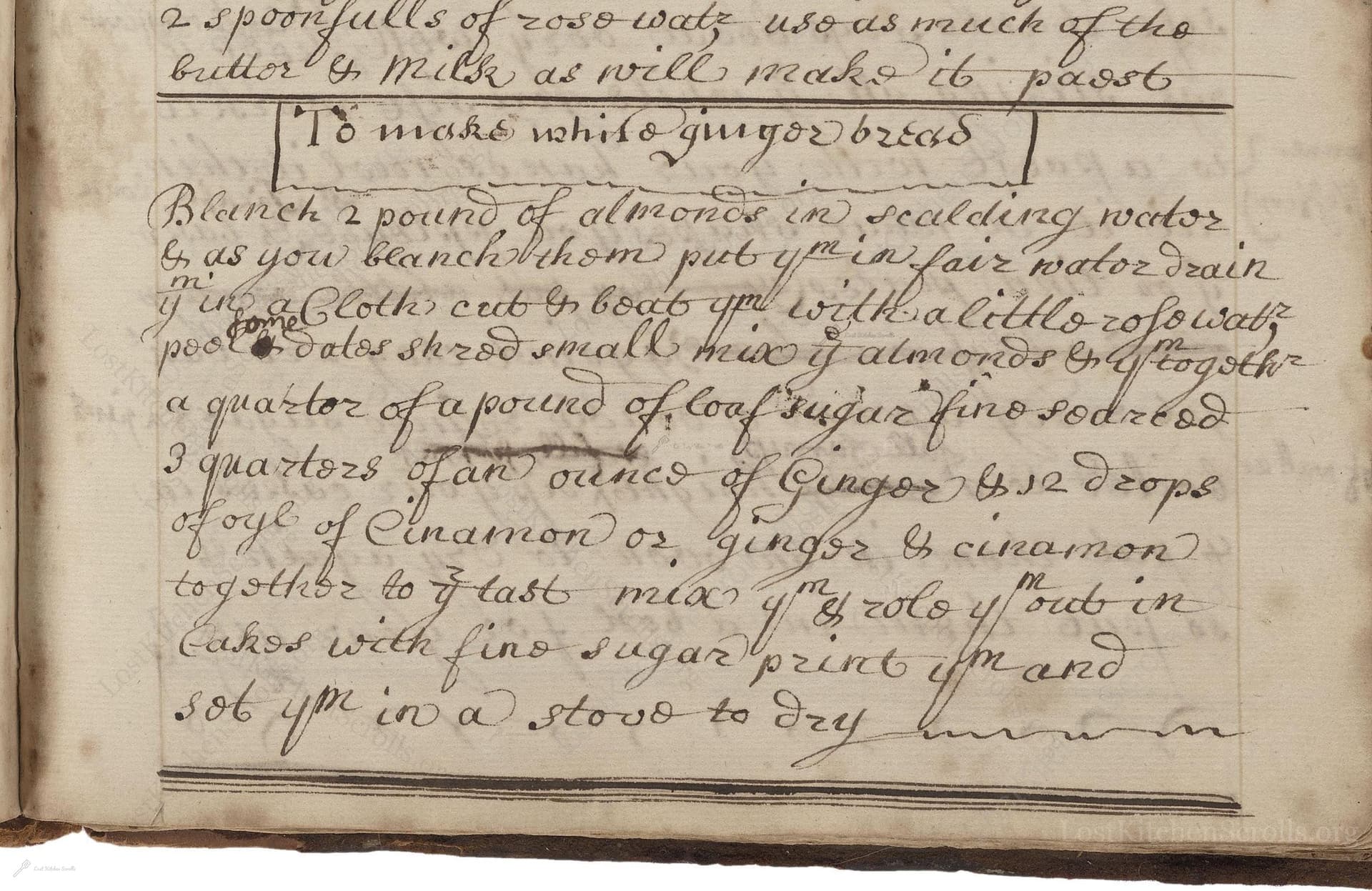To Make White Ginger Bread
From the treasured pages of English cookery and medicine book,
Unknown Author

To Make White Ginger Bread
"Blanch 2 pound of allmonds in secalding water & as you blanch them put ym in fair water drain ym in a Cloth rub & beat ym with a litle rose watr pool dates shred small mix it allmonds & all together a quarter of a pound of loaf sugar fine sodred 3 quarters of an ounce of Ginger & 12 drops of oyle of cinamon or ginger choyse to gether to ye tast mix ym & role ym in Cakes with fine sugar print ym and set ym in a stove to dry"
Note on the Original Text
The recipe is written in the informal, conversational style typical of late 17th-century household manuscripts. Measurements are approximate, and the sequence merges ingredients and methods freely. Spelling reflects pronunciation and was not standardized ('allmonds' for almonds, 'blanch' for blanching), and abbreviations like 'ym' for 'them' and 'ye' for 'the' are common. The method assumes familiarity with skills like blanching and grinding, relying on context and experience rather than explicit instructions. The absence of baking times or temperatures suggests it was a no-cook, dried sweet rather than a baked good.

Title
English cookery and medicine book, (1694)
You can also click the book image above to peruse the original tome
Writer
Unknown
Era
1694
Publisher
Unknown
Background
A delightful journey through late 17th to early 18th-century kitchens, this tome features recipes, culinary wisdom, and mouthwatering secrets from an era where feasts reigned supreme and the art of cooking was celebrated with flourish.
Kindly made available by
Folger Shakespeare Library
This recipe for 'white ginger bread' comes from an English household manuscript dating to around 1677-1711. Unlike the modern notion of gingerbread as a dark, molasses-rich cake or biscuit, 'white ginger bread' was a luxury confection based on almonds, fragrant waters, sugar, and spices. It likely appeared on the dessert table during feasts or special occasions among the gentry and aspiring middle classes. The presence of rosewater, costly spices, and almonds signals its place as a high-status treat, and its preparation reflects the period’s fascination with scented, molded sweets.

In the late 17th and early 18th centuries, almonds were blanched in a pot of boiling water and then ground in a mortar and pestle, sometimes with a little rosewater to prevent oiling. The sugar would be pounded fine, likely using a sugar loaf and a pestle. Dates were stoned and chopped with a knife. The mixture was worked by hand on a board, and cakes would be shaped either by hand or pressed into carved wooden molds. Cakes were set to dry in a warm corner of the kitchen, on wooden trays, or in a bread oven cooling down after baking.
Prep Time
30 mins
Cook Time
0 mins
Servings
20
We've done our best to adapt this historical recipe for modern kitchens, but some details may still need refinement. We warmly welcome feedback from fellow cooks and culinary historians — your insights support the entire community!
Ingredients
- 2 pounds whole almonds (blanched and ground)
- 1 tablespoon rosewater
- 3.5 ounces dates (stoned and finely chopped)
- 4 ounces powdered (icing) sugar
- 0.75 ounce (about 3 tablespoons) ground ginger
- 12 drops cinnamon oil or ginger oil (or strong extract/essence)
- Caster sugar, for dusting
Instructions
- Begin by blanching 2 pounds of whole almonds, placing them in boiling water for a minute, then quickly transferring them to cold water.
- Peel off the skins and let the almonds drain, then pat them dry with a clean cloth.
- Grind the almonds finely, using a little rosewater (about 1 tablespoon) to keep them moist and aromatic.
- Stone and finely chop about 3.5 ounces of dates, and mix them with the ground almonds.
- Add in 4 ounces of sifted powdered sugar, 0.75 ounce (about 3 tablespoons) dried ground ginger, and about 12 drops (less than 1/4 teaspoon) of cinnamon or ginger extract (use oil or, if unavailable, a few drops of strong essence).
- Mix thoroughly to a pliable dough.
- Dust your work surface with a little caster sugar.
- Roll the almond mixture into thick cakes or rounds, about 3/8–3/4 inch thick.
- If you like, stamp them with a decorative mold or press with a patterned rolling pin.
- Arrange the cakes on paper and allow them to dry in a warm place (such as a very low oven or dehydrator set at 105°F) for a few hours or overnight until firm but not hard.
Estimated Calories
230 per serving
Cooking Estimates
You'll spend about 30 minutes preparing the ingredients and forming the cakes. The cakes need to dry in a warm place for several hours or overnight, but that doesn't require any active work. Each serving contains around 230 calories, and the whole recipe makes about 20 pieces.
As noted above, we have made our best effort to translate and adapt this historical recipe for modern kitchens, taking into account ingredients nowadays, cooking techniques, measurements, and so on. However, historical recipes often contain assumptions that require interpretation.
We'd love for anyone to help improve these adaptations. Community contributions are highly welcome. If you have suggestions, corrections, or cooking tips based on your experience with this recipe, please share them below.
Join the Discussion
Rate This Recipe
Dietary Preference
Culinary Technique

Den Bockfisch In Einer Fleisch Suppen Zu Kochen
This recipe hails from a German manuscript cookbook compiled in 1696, a time whe...

Die Grieß Nudlen Zumachen
This recipe comes from a rather mysterious manuscript cookbook, penned anonymous...

Ein Boudain
This recipe comes from an anonymous German-language manuscript cookbook from 169...

Ein Gesaltzen Citroni
This recipe, dating from 1696, comes from an extensive anonymous German cookbook...
Browse our complete collection of time-honored recipes



